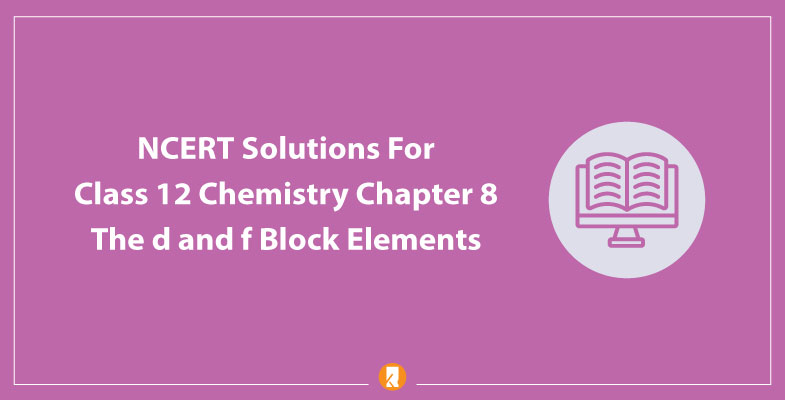NCERT Solutions For Class 12 Chemistry Chapter 8 the D and F Block Elements is an important study resource that includes answers to textbook problems, sample papers, and chemistry Class 12 Chapter 8 exercise solutions, as well as answers to previous year’s important questions.
- All you need to know about: Class 12 Chemistry NCERT Solutions
These solutions are easy to comprehend and presented in a straightforward manner. Students can use the solutions for the D and F block elements offered here to clear up any doubts they may have and better comprehend the principles.
NCERT Solutions For Class 12 Chemistry Chapter 8 PDF: The d and f Block Elements
Chapter 8 Class 12 Chemistry NCERT Solutions PDF
Class 12th Chemistry Chapter 8 NCERT Solutions PDF:
The d and f blocks of the modern periodic table are covered in Chapter 8 Class 12 Chemistry NCERT Solutions. The electrical configuration and general features of transition elements, as well as oxidation and chemical reactivity, are all covered in this chapter. This chapter is critical for students taking 12th board exams because it contains a number of important questions. The NCERT Solutions for Class 12 Chemistry Chapter 8 are really useful in this regard.
Chapter 8 Class 12 Chemistry NCERT Solutions (D and F Block Elements) – Important Questions
Below are some essential questions from the f and b block elements for both short and very short questions.
1. Explain why the Cu+ ion is not stable in an aqueous solution?
2. What is the stronger reducing agent Cr2+ or Fe2+, and why?
3. Why is the highest oxidization state of metal exhibited in its oxide and fluoride only?
4. Which of the 3d series of transition metals exhibits the largest numbers of oxidized states and why?
5. The silver atom has filled the d orbit (4d10) in its ground state, then how can you state that it is a transition element?
Class 12th Chemistry Chapter 8 NCERT Solutions
The elements of the d and f blocks of the current periodic table are discussed in class 12th chemistry chapter 8 NCERT Solutions. Students will learn about the electronic configuration, occurrence, and general characteristics of transition elements in this chapter, with a focus on trends in the properties of the first row (3d) transition metals, as well as the synthesis and properties of a few significant compounds.
Following that, general properties of the inner transition metals’ electrical configurations, oxidation states, and chemical reactivity will be considered.
Subtopics of Ch 8 Chemistry Class 12 NCERT Solutions: Important Topics
- Position in the Periodic Table
- Electronic Configurations of the d-Block Elements
- General Properties of the Transition Elements (d-Block)
- Some Important Compounds of Transition Elements
- The Lanthanoids
- The Actinoids
- Some Applications of d- and f-Block Elements
Other Important Links Related To Class 12 Chemistry
Here you can check links to various study materials related to the 12th Chemistry:
Benefits of NCERT Solutions For Class 12 Chemistry Chapter 8
The following benefits of using the PDF files for chapter 8 solutions can help you learn more effectively:
- Diagrams are used to explain the problem.
- Appropriate examples are provided for clarification.
- Expertly formulated responses.
- Questions are answered in detail, step by step.
- Updated to satisfy CBSE requirements.
We have covered the detailed guide on CBSE Class 12 Chemistry NCERT Solutions Chapter 8. Feel free to ask any questions in the comment section below.
FAQs on Class 12 Chemistry NCERT Solutions for Chapter 8
What are d and f block elements?
The d-block of the periodic table consists of elements from groups 3–12 in which the d orbitals are progressively filled in each of the four longer positions. The f-block consists of elements in which the 4 f and 5 f orbitals are progressively filled. They are placed in a separate panel at the bottom of the periodic table.
Will I be able to clear my doubts using the NCERT Solutions for Class 12 Chemistry Chapter 8?
Yes. Chemistry Experts prepare this solution with utmost care with the main aim of helping the students in their board exam preparation.
How many marks Chapter 8 of NCERT Solutions for Class 12 Chemistry carry in Board Exams?
Chapter 8 carries 5 marks with short and very short answer-type questions.
Where can I download NCERT Solutions For Class 12 Chemistry Chapter 8 The d and f Block Elements?
You can download NCERT Solutions For Class 12 Chemistry Chapter 8 from the above article.
Why is the magnetic moment of F block elements greater than that of D block elements?
The magnetic moment depends on the number of unpaired electrons. Since the elements in block d do not have the availability of unpaired electrons, their magnetic moment is less than the elements in block f.
Why should I refer to the NCERT Solutions for Class 12 Chemistry Chapter 8?
You must refer to the NCERT Solutions for Class 12 Chem Chapter 8 to understand the concepts easily and get the solutions designed by the subject experts.
What are the benefits of NCERT Solutions For Class 12 Chemistry Ch 8?
Go through the above article for the list of benefits of using NCERT Solutions For Class 12 Chemistry Chapter 8.
